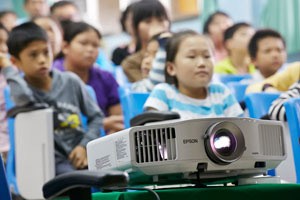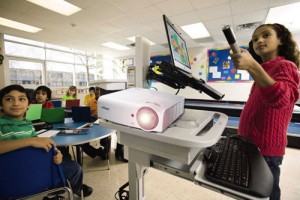Protecting your child from digital eye strain
 Learn the warning signs of digital eye strain and how to protect your child’s eyesight.
Learn the warning signs of digital eye strain and how to protect your child’s eyesight.
The combination of computers, tablets and whiteboard projectors at home and at school are contributing to eye problems in younger and younger children. Here’s how to recognize the symptoms of digital eye strain (known as CVS — computer vision syndrome) and some of the preventive tips to be taken.
Causes of CVS
According to a 2014 survey conducted by the American Optometric Association (AOA), 83% percent of children between the ages of 10 and 17 are using some kind of electronic device three to four hours a day. Eye doctors consider this to be too much screen time.
 When staring at a computer screen, tablet or cell phone, we tend to blink less. Since our eyes work harder to see thing closer than in the distance, sitting too close to the small screens can lead to muscle fatigue. Over time the eyes get weaker, more easily tired and strained. This can cause CVS digital eye strain.
When staring at a computer screen, tablet or cell phone, we tend to blink less. Since our eyes work harder to see thing closer than in the distance, sitting too close to the small screens can lead to muscle fatigue. Over time the eyes get weaker, more easily tired and strained. This can cause CVS digital eye strain.
Our eyes are designed to look straight ahead and down slightly. A computer monitor too high or a projector screen off to the side makes your eyes work in an unnatural position, also causing strain. Eye muscles work harder which causes them to get strained. Children have a tendency to also sit too close to their cell phone, tablet or monitor, which also contributes to weaker eyes.
Today’s smartphones, tablets, flat screen TVs and LED monitors and projectors emit cool blue light that also contributes to eye strain and discomfort. There are also growing concerns that these blue light can cause retina damage since it stimulate the retina’s blue cells as it passes through the cornea leading to serious conditions such as age-related macular degeneration (AMD).

CVS Symptoms
Digital eyestrain also known as computer vision syndrome (CVS) is showing up in children more frequently. The same AOA survey found that parents and teachers underestimate how much time our children are spending on electronic devices.
While adults are self-aware about the problem most kids don’t make the connection between screen time and sore eyes. The AOA recommend teachers and parents that children learn the warning signs of CVS that include:
- dry eyes
- blurry vision
- burning sensation
- headaches
- shoulder pain
- fatigue
Protecting our children’s eyesight
 The AOA has put out guidelines for both the classroom and at home to help prevent or reduce digital eyestrain:
The AOA has put out guidelines for both the classroom and at home to help prevent or reduce digital eyestrain:
- Take a break. Follow the 10-10-10 rule which means which means every 10 minutes take a 10 second break and look at something 10 feet away. This reduces eyestrain and helps the eyes to relax.
- Keep blinking to keep the eyes moist.
- Computer screens should be only four to five inches below eye level and 20 to 28 inches away from the eyes.
- Handheld devices should be held away at a safe distance.
- Check for glare on the screen so that no light sources are directly visibly on the computer monitor.
- Adjust the brightness of the screen and change the background color.
- Reduce the amount of lighting in the room to match the computer screen. Bright overhead light should be on a dimmer switch.
- Increase the font size on the computer to reduce eyestrain.
- Teach students never to stare directly into the projector beam and always step outside the beam when approaching the projector at school or at home.

Leave a Reply